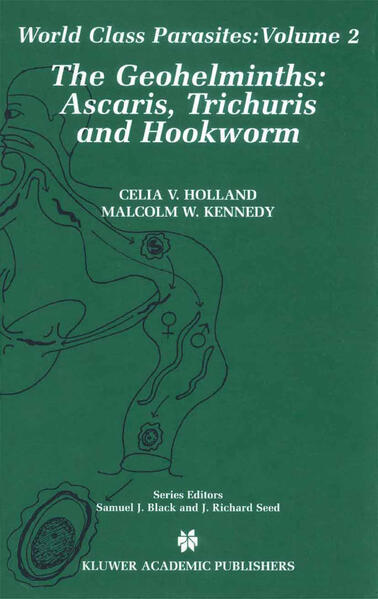
Sofort lieferbar (Download)
The soil-transmitted nematode parasites, or geohelminths, are - called because they have a direct life cycle, which involves no intermediate hosts or vectors, and are transmitted by faecal contamination of soil, foodstuffs and water supplies. They all inhabit the intestine in their adult stages but most species also have tissue-migratoryjuvenile stages, so the disease manifestations they cause can therefore be both local and systemic. The geohelminths together present an enormous infection burden on humanity. Those which cause the most disease in humans are divided into three main groupings, Ascaris lumbricoides (the large roundworm), Trichuris trichiura (whipworm), and the blood-feeding hookworms (Ancylostoma duodenale and Necator americanus ), and this book concentrates on these. These intestinal parasites are highly prevalent worldwide, A. lumbricoides is estimated to infect 1471 million (over a quarter ofthe world's population), hookworms 1277 million, and T. trichiura 1049 million. The highly pathogenic Strongyloides species might also be classified as geohelminths, but they are not dealt with here because the understanding of their epidemiology, immunology and genetics has not advanced as rapidly as for the others. This is primarily because of the often covert nature of the infections, with consequent difficulties for analysis. If there is ever a second edition of this book, then there will hopefully be much to say about this infection.
Inhaltsverzeichnis
Epidemiological Patterns and Consequences.- Distributions and Predisposition: People and Pigs.- Control Strategies.- The Cost and the Damage Done.- Pathophysiology of Intestinal Nematodes.- Intestinal Nematodes and Cognitive Development.- The Economics of Worm Control.- Immunology Mice, Pigs and People.- Immune Responses on Humans Ascaris.- Immunity and Immune Responses to Ascaris Suum in Pigs.- Immune Responses in Humans Trichuris trichiura.- The Immunobiology of Hookworm Infection.- Genetics Mice, Worms and People.- Human Host Susceptibility to Intestinal Worm Infections.- Population Genetics of Intestinal Nematodes.- Parasite Strain Diversity and Host Immune Responses.- The Value of Mutation Scanning Approaches for Detecting Genetic Variation Implications for Studying Intestinal Nematodes of Humans.- Opportunities and Prospects for Investigating Developmentally Regulated and Sex-Specific Genes and Their Expression in Intestinal Nematodes of Humans.- Interaction between Geohelminth Infections and Other Diseases.- Schistosomiasis and Reduced Risk of Atopic Diseases: New Insights and Possible Mechanisms.- Geohelminths, HIV/AIDS and TB.
Produktdetails
Erscheinungsdatum
11. April 2006
Sprache
englisch
Auflage
2002
Seitenanzahl
335
Dateigröße
9,35 MB
Reihe
World Class Parasites
Herausgegeben von
Celia V. Holland, Malcolm W. Kennedy
Verlag/Hersteller
Kopierschutz
mit Wasserzeichen versehen
Produktart
EBOOK
Dateiformat
PDF
ISBN
9780306473838
Entdecken Sie mehr
Bewertungen
0 Bewertungen
Es wurden noch keine Bewertungen abgegeben. Schreiben Sie die erste Bewertung zu "The Geohelminths" und helfen Sie damit anderen bei der Kaufentscheidung.









